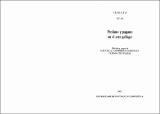Por favor, use este identificador para citar o enlazar a este item:
http://hdl.handle.net/10261/6757COMPARTIR / EXPORTAR:
 SHARE
BASE SHARE
BASE
|
|
| Visualizar otros formatos: MARC | Dublin Core | RDF | ORE | MODS | METS | DIDL | DATACITE | |

| Campo DC | Valor | Lengua/Idioma |
|---|---|---|
| dc.contributor.author | Santos-Estévez, Manuel | - |
| dc.date.accessioned | 2008-08-18T15:04:02Z | - |
| dc.date.available | 2008-08-18T15:04:02Z | - |
| dc.date.issued | 2003 | - |
| dc.identifier.citation | En Castiñeiras González, M.A.; Díez Platas, F. (eds.) Profano y pagano en el arte gallego. Semata, Ciencias Sociais e Humanidades. | en_US |
| dc.identifier.citation | Vol.14 pp.39-94 Lugar: Santiago de Compostela | en_US |
| dc.identifier.issn | 1137-9669 | - |
| dc.identifier.uri | http://hdl.handle.net/10261/6757 | - |
| dc.description.abstract | [EN]The following two essays (Rock Art and Shrines in the Iron Age and Images, Text, Landscapes and Ideas: castreño shrines in context), whilist having been conceived autonomously and presented in accordance with a specific and independent internal logic, are in fact closely linked. They study the known data in Galician archaeological record, put forward only recently. The first essay presents the archaeological data which justifies the definition of a new type of site which has a sacred purpose: that of a shrine. Furthermore, arguments are given for the dating of the site to the Iron Age. The second essay starts with the iconographic motifs found in these very shrines, and analyses them in accordance with the comparative method to show, on the one hand, the conceptual continuity between pre-roman petroglyphs and circular iconography of Mediterranean influence and, on the other, the link between those shrines and motifs with others better known in the European Iron Age which, culturally, are the most part Celtic | en_US |
| dc.description.abstract | [ES] Los dos trabajos que siguen (Arte Rupestre y recintos rituales en la Edad del Hierro e Imágenes. Textos, Paisajes e Ideas: Los santuarios castreños en contexto) aunque concebidos de forma autónoma y presentados de acuerdo con una lógica interna específica e independiente, son estrechamente solidarios. En ellos se estudian los mismos hechos del registro arqueológico gallego conocidos y presentados desde hace poco tiempo. En el primer trabajo se presentan esos datos arqueológicos justificativos de la definición de un tipo de yacimiento nuevo, que tiene una finalidad sagrada: un santuario. Además se presentan los argumentos que apuntan a su datación en la Edad del Hierro. En el segundo trabajo se parte de motivos iconográficos presentes en esos mismos santuarios y se analizan de acuerdo con el método comparativo para mostrar, por un lado, la continuidad conceptual entre petroglifo prerromano e iconografía en bulto redondo de influjo mediterráneo y, por otro lado, la solidaridad de esos santuarios y motivos con otros mejor conocidos en le Edad del Hierro europea que, culturalmente, es en buena parte céltica. | en_US |
| dc.format.extent | 1898810 bytes | - |
| dc.format.mimetype | application/pdf | - |
| dc.language.iso | spa | en_US |
| dc.publisher | Universidad de Santiago de Compostela | en_US |
| dc.rights | openAccess | en_US |
| dc.subject | Laboratorio de Arqueología del Paisaje | en_US |
| dc.subject | Laboratory of Landscape Archaeology | en_US |
| dc.subject | Santuarios | en_US |
| dc.subject | Shrines | en_US |
| dc.subject | Celtas | en_US |
| dc.subject | Celts | en_US |
| dc.subject | Arte rupestre | en_US |
| dc.subject | Rock Art | en_US |
| dc.subject | Petróglifos | en_US |
| dc.subject | Petroglyphs | en_US |
| dc.subject | LaPa | - |
| dc.title | Arte Rupestre y Santuarios. I. Arte rupestre y recintos rituales en la Edad del Hierro | en_US |
| dc.type | capítulo de libro | en_US |
| dc.description.peerreviewed | Peer reviewed | en_US |
| dc.type.coar | http://purl.org/coar/resource_type/c_3248 | es_ES |
| item.openairetype | capítulo de libro | - |
| item.grantfulltext | open | - |
| item.cerifentitytype | Publications | - |
| item.openairecristype | http://purl.org/coar/resource_type/c_18cf | - |
| item.fulltext | With Fulltext | - |
| item.languageiso639-1 | es | - |
| Aparece en las colecciones: | (IEGPS) Libros y partes de libros | |
Ficheros en este ítem:
| Fichero | Descripción | Tamaño | Formato | |
|---|---|---|---|---|
| Arte Rupestre y Santuarios. I. Arte rupestre y recintos rituales en la Edad del Hierro.pdf | 1,85 MB | Adobe PDF |  Visualizar/Abrir |
CORE Recommender
Page view(s)
665
checked on 23-abr-2024
Download(s)
608
checked on 23-abr-2024
Google ScholarTM
Check
NOTA: Los ítems de Digital.CSIC están protegidos por copyright, con todos los derechos reservados, a menos que se indique lo contrario.
